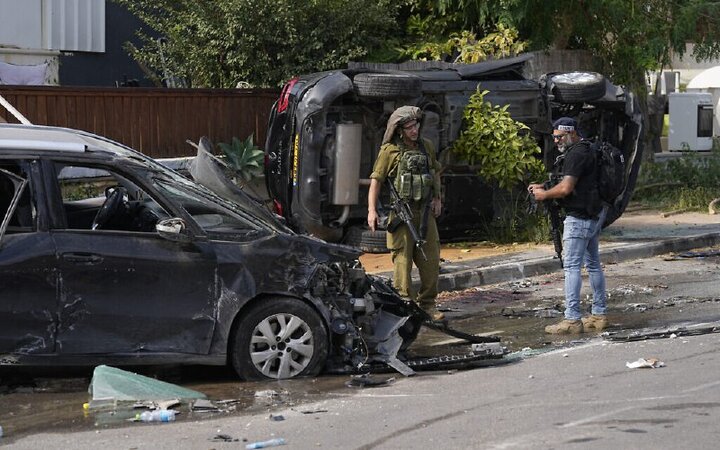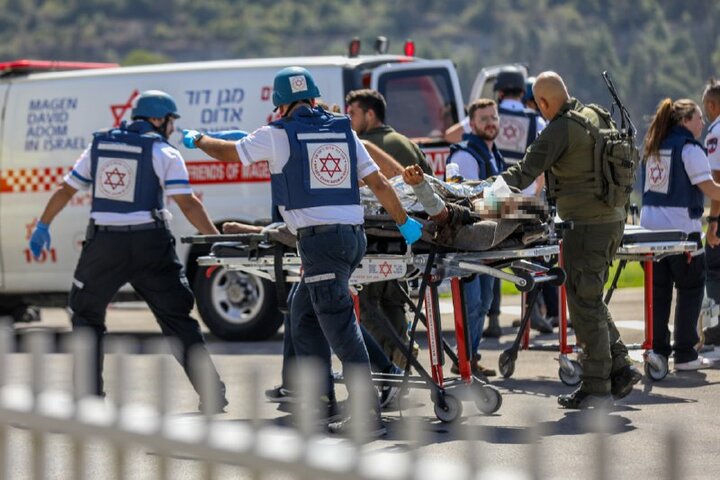Shock and Awe Continue

TEHRAN- Hamas began its offensive - which it named "Operation al-Aqsa Storm" - on Saturday with a barrage of missiles from Gaza followed by resistance fighters crossing the strongly fortified separation wall.
More than 24 hours have passed since the operation of the Palestinian resistance and attacks are still ongoing with 100s of rockets being launched at Israeli settlements along with various intrusions that have been made into Israeli settlements.
Major doubts and a state of confusion continue amid Israeli officials.
The resistance began its offensive with a barrage of missiles from Gaza followed by its forces crossing the wall separating the besieged Gaza Strip from the rest of the world.
How Did Hamas Infiltrate the Occupied Palestinian Territories?
Here is what we know so far about how the unprecedented Palestinian operation that unfolded on Saturday morning.
7 am: Hamas launches rockets
The operation started just before 7 a.m. local time and came without warning.
The first Israelis that knew about it was by air raid sirens in the southern settlements near Gaza.
Explosions were reported in many settlements across the Israeli-occupied Palestinian territories, including Tel Aviv, Ashkelon, Yavne and Kfar Aviv, while large plumes of black smoke were seen rising from a number of smaller Israeli settlements.
Hamas's top military commander, Mohammad Deif, said the number of missiles fired in the initial phase was 5,000.
7.30 am: Clashes on the Gaza border
Under the cover of rocket fire, Hamas forces crossed into the occupied territories using a number of methods.
These included (for the first time) paragliders as well as boats and also on foot and via jeeps, from nearly two dozen points.
A video showed Hamas fighters flying across the separation wall.
The footage emerged as Hamas released a video showing its fighters practicing to use the paragliders in preparation for the operation.
Armed clashes took place between the resistance and the regime's troops along the separation fence near the southern town of Khan Younis.
Meanwhile, Hamas released footage showing a drone dropping an explosive device that precisely struck its target: an Israeli tank on the other side of the wall.
The sophistication and planning of the operation show a major failure for Israeli intelligence.
8 am: Hamas confirms responsibility
Around 8 a.m. local time, Hamas claimed responsibility and announced it had started a new offensive against Israel.
The group also called on other resistance factions to join the operation.
8.30 am: Israel calls up reservists
Around 30 minutes later, Israeli minister of war Yoav Gallant approved the call-up of military reservists, while the Palestinian Islamic Jihad said its forces had joined the operation.

Meanwhile, the regime's military confirmed its troops had clashed with Hamas fighters at Erez Crossing - also known as the Beit Hanoun Crossing - at the separation wall between the Gaza Strip and the occupied Palestinian territories.
They also confirmed that the fighting had taken place at the Israeli Zikim military base to the south of Ashkelon.
Footage then emerged of another Israeli tank on fire at the Gaza Strip fence east of Khan Younis and, later, an Israeli armored vehicle being driven into Shejaiya in Gaza.
Around this time, the Israeli military announced air raids on Gaza and said an "extensive" mobilization process had begun.
Explosions were reported across central Gaza and in Gaza City throughout the day and night.
11am: Netanyahu says Israel is "at war"
Around 6 p.m. local time, Hamas releases new footage
Hamas publishes footage through its war media channel. The footage shows an attack on an Israeli military base. The bodies of dead Israeli troops are seen on the ground.
A cache of weapons is displayed while other sections of the video show Hamas forces dragging Israeli soldiers away from the base.
In other developments.
24 hours after the Hamas-led incursion began, resistance forces were still fighting inside several Israeli settlements.
Israel's military spoke of battles still taking place in nearly two dozen locations.
The Palestinian resistance says it has taken a large number of Israeli troops and settlers as prisoners of war.
It comes after Israel's military confirmed settlers and troops have been taken to Gaza.
While the Israeli military has not confirmed exact figures, the Israeli embassy to the United States says over 100 Israeli troops and [settlers] have been kidnapped by Hamas forces.
The unknown number of Israeli soldiers and settlers that have been captured and taken into Gaza is an enormously sensitive issue for Israel.
Top Hamas commander Abu Obeida has said "dozens" of Israeli troops are being held in "safe places" and tunnels in the Gaza Strip.
Another top official, Saleh Arouri, told Al Jazeera that the group is holding "a large number" of Israeli prisoners - enough captives to make Israel free all Palestinians in its jails.

Israeli news networks are now reporting that between 500 to 600 Israelis have died as a result of the Hamas incursion yesterday.
Over 2,000 others have been injured as a result of the Palestinian operation, with many in serious condition, Israeli media reports have said.
Israeli air raids have killed at least 370 Palestinians in the Gaza Strip, with a further 2,200 injured, according to Gaza's health ministry.
The death toll is expected to rise on both sides.
According to Israeli news channel N12, 50 Israelis were being held by Hamas forces in the Beeri Kibbutz settlement near Gaza.
An Israeli news outlet spoke to a besieged woman inside the Beeri settlement, who says she has been left without electricity since 12 p.m. on Saturday.
"We have been sitting for 10 hours in different positions," she says.
"We hope that we will soon know what to do and that we can go out."
Asked if there were still fighters in the settlement, the woman said, "I believe so".
"We have very little water," she added.
Analysts say the interview reflects the plight of two million Palestinians living under siege in the Gaza Strip since 2007, also known as the world's largest open air prison.
Social media footage shows a number of Israelis being captured and transferred to the Gaza Strip.
An Israeli military spokesman said that hostage situations were ongoing in some settlements near Gaza throughout the night.
In a massive salvo, Hamas fired 150 missiles toward Tel Aviv, the group's armed wing has said.
The al-Qassam Brigades said the attack had been launched in response to the Israeli bombardment of a residential tower in Gaza with 100 apartments.
"In response to the bombing of the residential tower in the center of Gaza City...the Al-Qassam Brigades now direct a major missile strike with 150 missiles toward Tel Aviv," it wrote on social media.
It did not give any further details.
By late Saturday night, the commander of Israel's Nahal Brigade had been killed, which the regime's military said occurred during an "encounter with a [resistance fighter]", in a sign of how intense the battle has become.
Israel's military spokesman said it is striking targets in Gaza from the air.
Israel’s warplanes have bombed the house of Hamas Gaza chief Yehya al-Sinwar, the resistance group's media has said.
Al-Sinwar's home in Khan Younis in the southern Gaza Strip was targeted by the warplanes, it added. It also said no casualties have been reported.

According to diplomats, the United Nations Security Council was due to meet on Sunday.
It came after Brazil announced it would convene an emergency session after Hamas launched the biggest attack on Israeli-occupied Palestinian territories.
UN Secretary-General Antonio Guterres has urged "all diplomatic efforts to avoid a wider conflagration," UN spokesperson Stephane Dujarric said.
"The secretary-general is deeply concerned for the civilian population and urges maximum restraint," he added.
"Civilians must be respected and protected in accordance with international humanitarian law at all times."
"We are on the verge of a great victory and clear conquest on the Gaza front," Ismail Haniyeh, the Hamas political bureau chief, said in a televised speech.
"Hamas is fighting the battle with all the resistance factions and the heroes of the Palestinian people. We see scenes of heroism from men who were true to what they promised God and created the gateway to the great victory for our people and our nation."
"We say to all countries, including our Arab brothers, that this entity, which cannot protect itself in the face of resistance forces, cannot provide you with any protection,” the Hamas chief said, adding, "All the normalization agreements that you signed with that entity cannot resolve this (Palestinian) conflict."
Many of the Palestinians killed by Israeli air raids are civilians, according to health officials.
A nurse and an ambulance driver are among those killed in Israeli strikes on two hospitals in Gaza, a medical aid group has said.
The attacks injured several people and damaged an oxygen station, Medecins Sans Frontieres said.
"Following the escalation between Israel and Gaza, Israeli forces struck the enclave's Indonesian hospital and an ambulance in front of Nasser Hospital in southern Gaza," it said.
The U.S. Secretary of State Anthony Blinken has discussed measures to bolster Israel's security in calls with the regime's officials, according to the State Department.
Leave a Comment